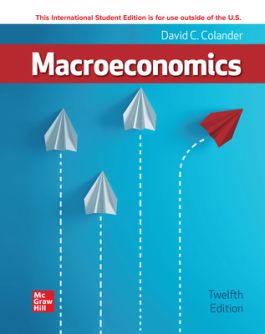Macroeconomics ISE
Chapter 1: Economics and Economic Reasoning
Chapter 2: The Production Possibility Model, Trade, and Globalization
Appendix: Graphish: The Language of Graphs
Chapter 3: Economic Institutions Appendix: The History of Economic Systems
Chapter 4: Supply and Demand
Chapter 5: Using Supply and Demand
Appendix: Algebraic Representation of Supply, Demand, and Equilibrium
PART II: MACROECONOMICS
MACROECONOMIC BASICS
Chapter 6: Economic Growth, Business Cycles, and Unemployment
Chapter 7: Measuring and Describing the Aggregate Economy
POLICY MODELS
Chapter 8: The Keynesian Short-Run Policy Model: Demand-Side Policies
Chapter 8W: The Multiplier Model
Chapter 9: The Classical Long-Run Policy Model: Growth and Supply-Side Policies
FINANCE, MONEY, AND THE ECONOMY
Chapter 10: The Financial Sector and the Economy
Appendix: A Closer Look at Financial Assets and Liabilities
Chapter 11: Conventional Monetary Policy
Chapter 12: Financial Crises, Regulation, and the Crypto Challenge
TAXES, BUDGETS, AND FISCAL POLICY
Chapter 13: Deficits and Debt: The Austerity Debate
Chapter 14: The Fiscal Policy Dilemma
MACROECONOMIC PROBLEMS
Chapter 15: Jobs and Unemployment
Chapter 16: Inflation, Deflation, and Macro Policy
INTERNATIONAL ECONOMIC POLICY ISSUES
Chapter 17: Comparative Advantage, Exchange Rates, and Globalization
Chapter 18: International Trade Policy
INTERNATIONAL MACROECONOMIC POLICY ISSUES
Chapter 19: International Financial Policy
Appendix: History of Exchange Rate Systems
Chapter 20: Macro Policy in a Global Setting
Chapter 21: Structural Stagnation, Globalization and the Post-COVID Blues
Chapter 22: Macro Policy in Developing Countries
David Colander’s trademark colloquial approach focuses on modern economics, institutions, history, and modeling. He presents and applies economic models, but also encourages students to think about model nuances, building their critical thinking skills and applying models to the real world.
Content in this text is organized around learning objectives to make it easier for students to understand the material and for instructors to build assignments within Connect. Through Connect and SmartBook, students will find engaging activities, helpful tutorial videos, and learning resources at that moment of need.
McGraw Hill Connect is an award-winning digital teaching and learning solution that empowers students to achieve better outcomes and enables instructors to improve course management efficiency.
High-Quality Course Material
Our trusted solutions are designed to help students actively engage in course content and develop critical higher-level thinking skills while offering you the flexibility to tailor your course to the ways you teach and the ways your students learn.
Assignments & Automatic Grading
Connect features a question bank that you can select from to create homework, practice tests and quizzes. Dramatically reduce the amount of time you spend reviewing homework and grading quizzes, freeing up your valuable time to spend on teaching.
Analytics & Reporting
Monitor progress and improve focus with Connect’s visual and actionable dashboards. Reports are available to empower both instructors and students with real-time performance analytics.
Seamless Integration
Link your Learning Management with Connect for single sign-on and gradebook synchronization, with all-in-one ease for you and your students.


